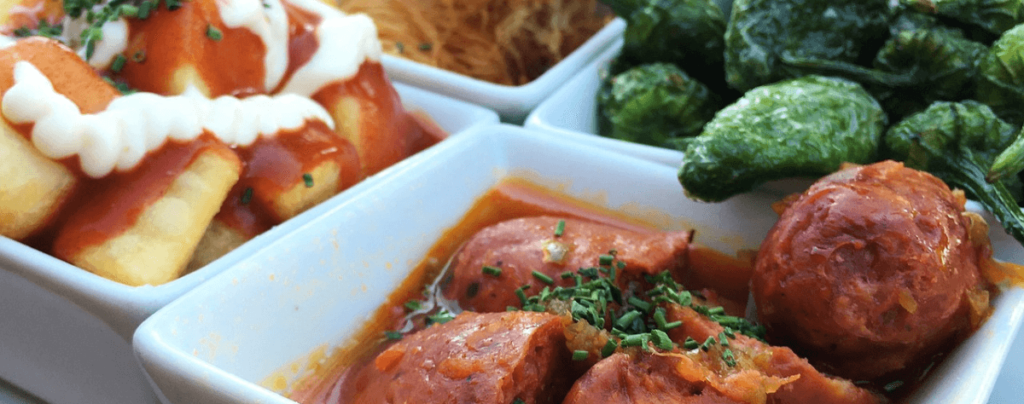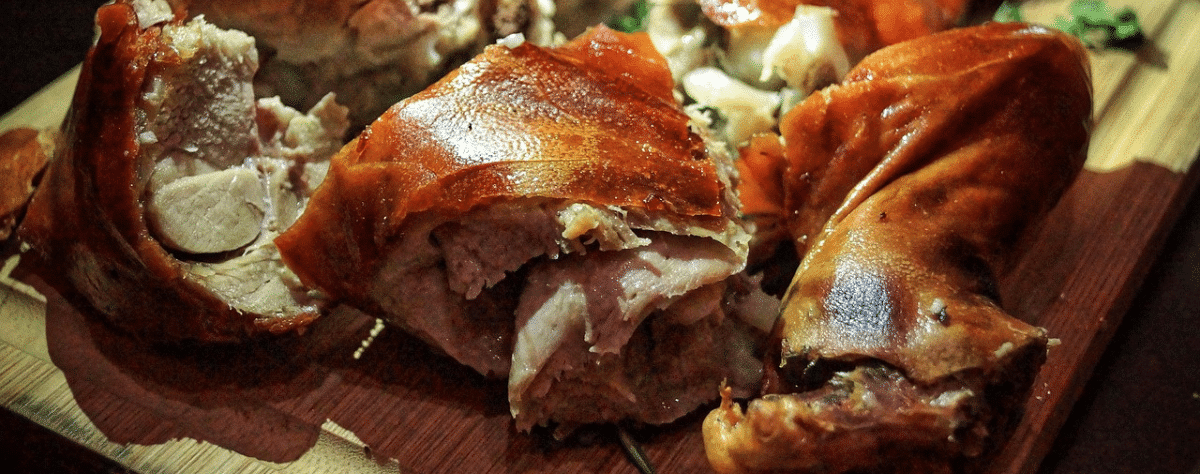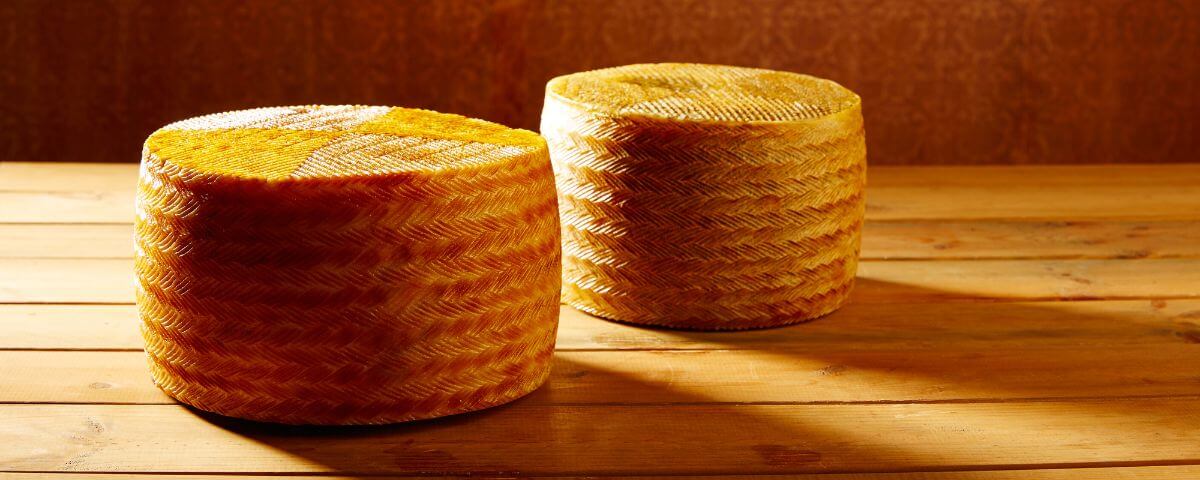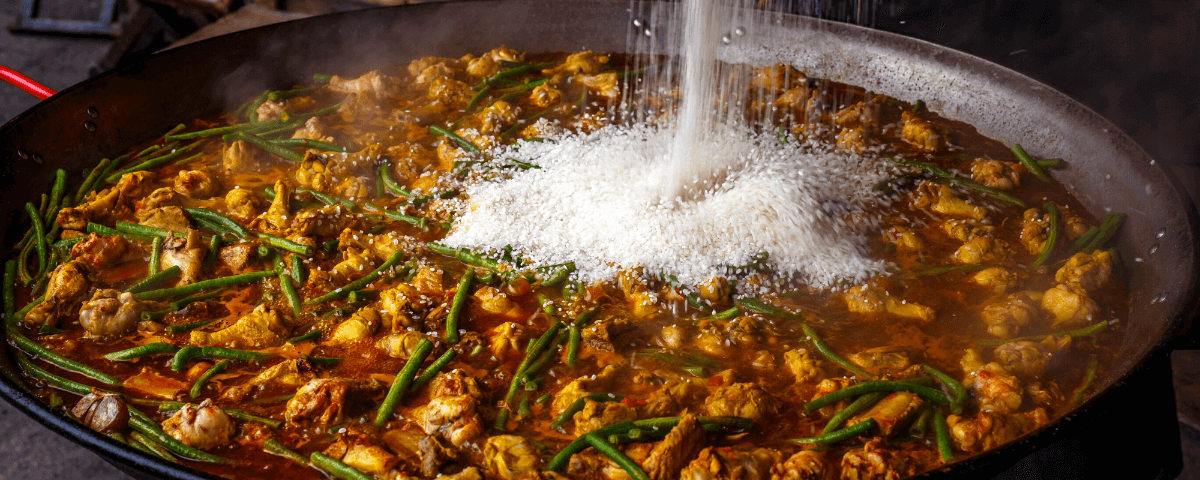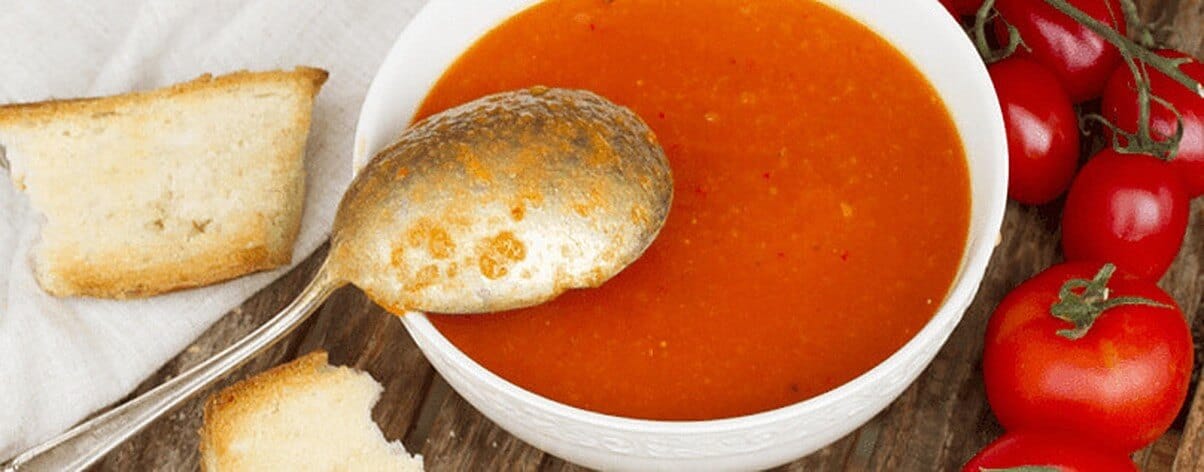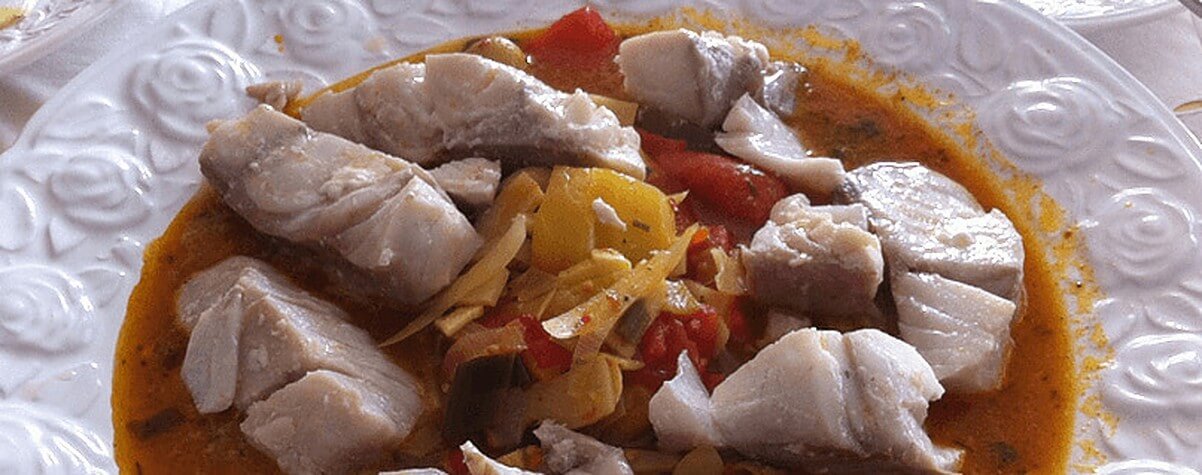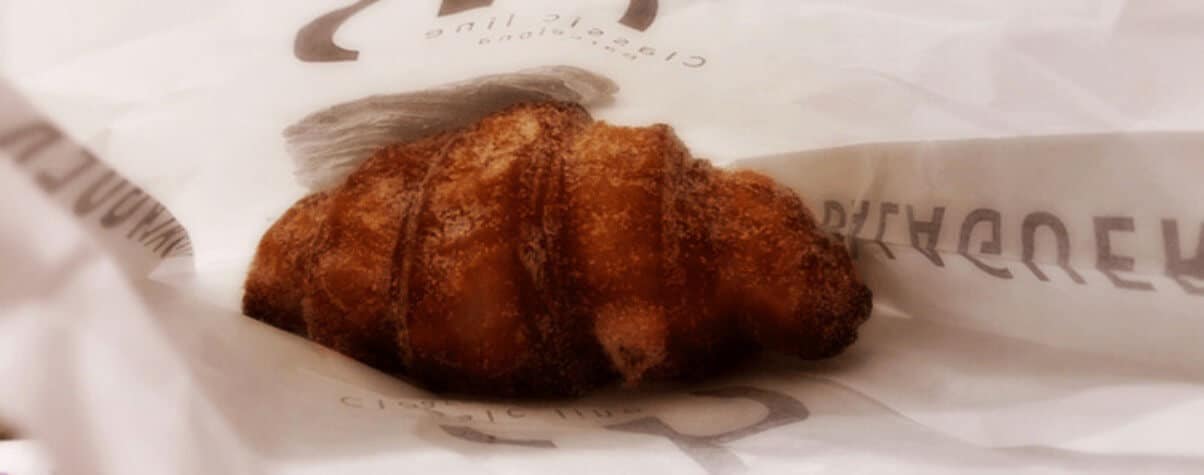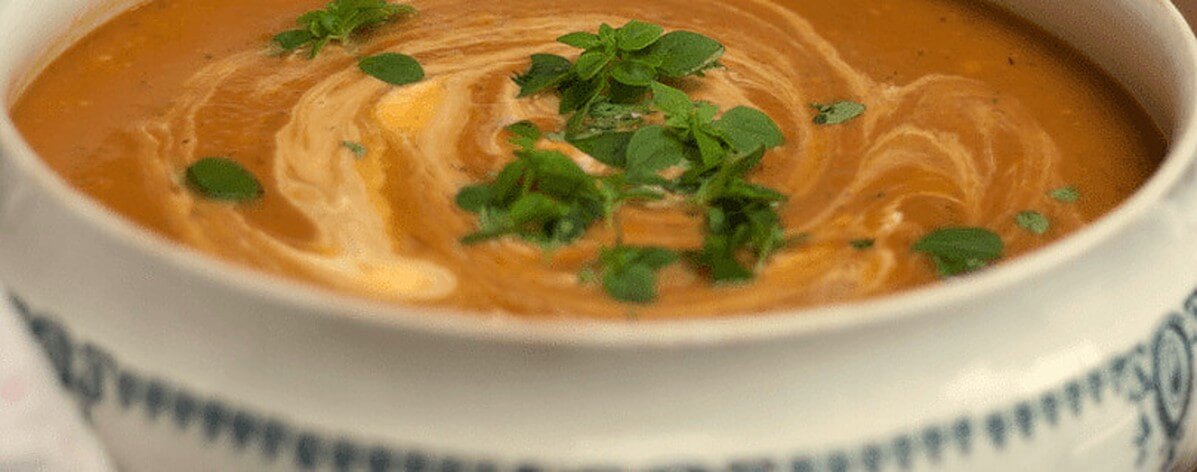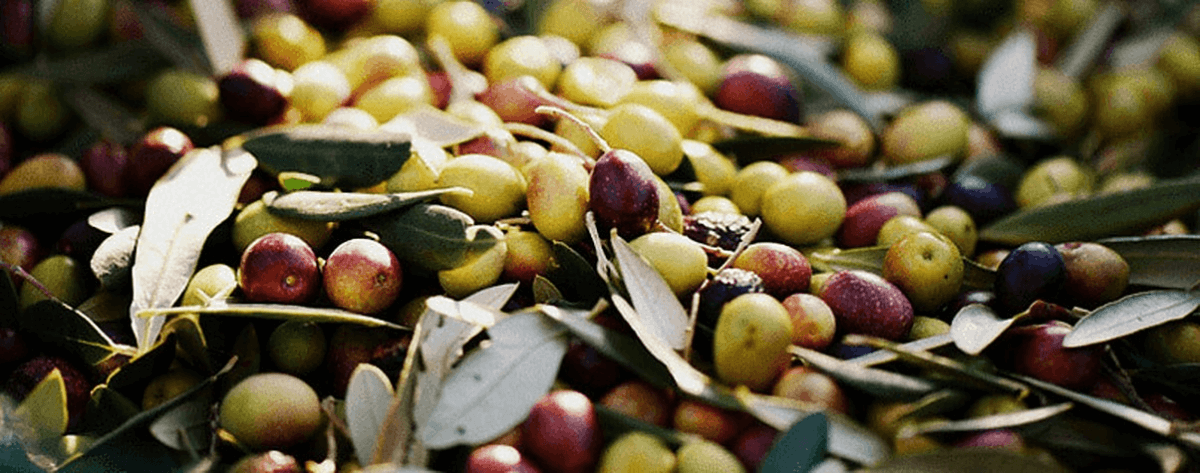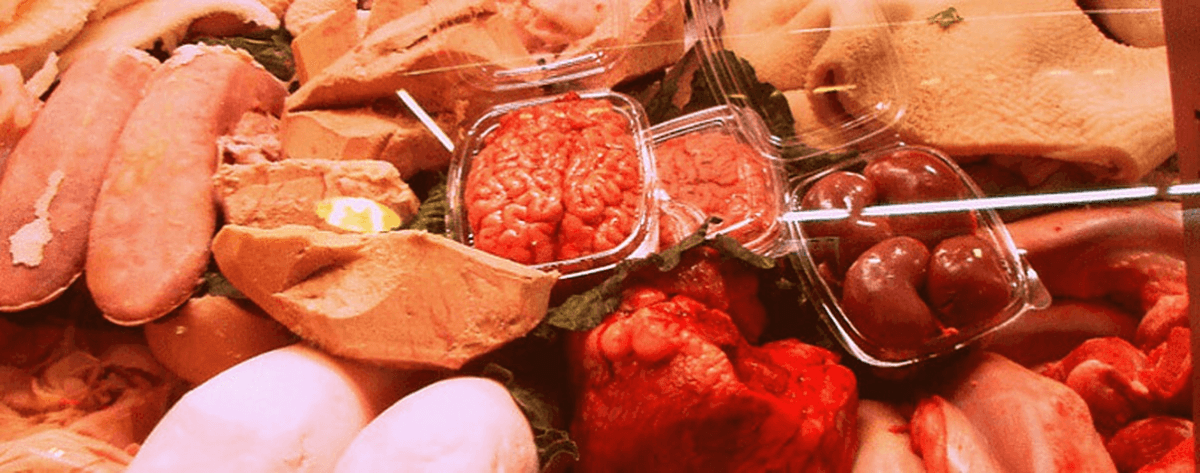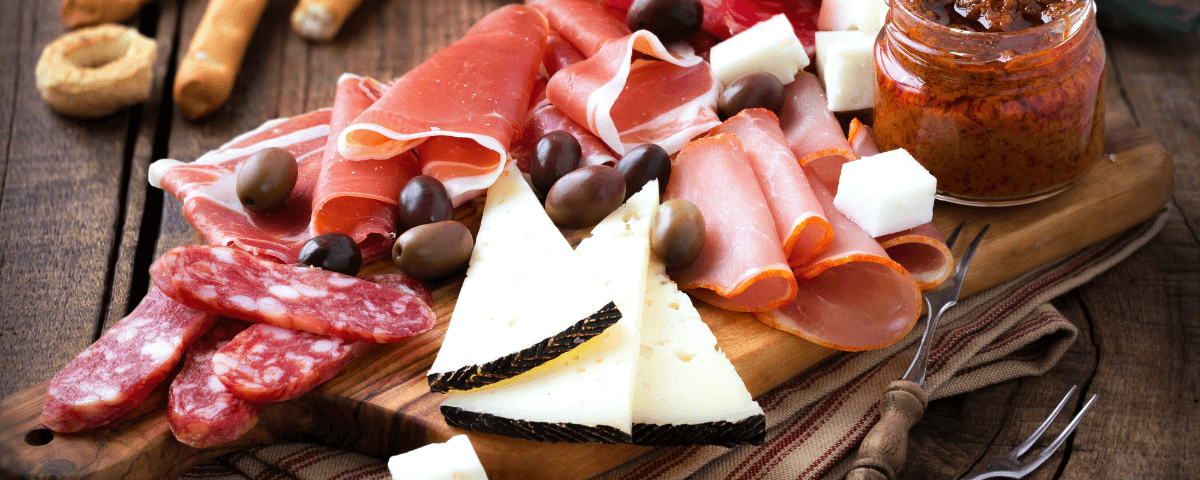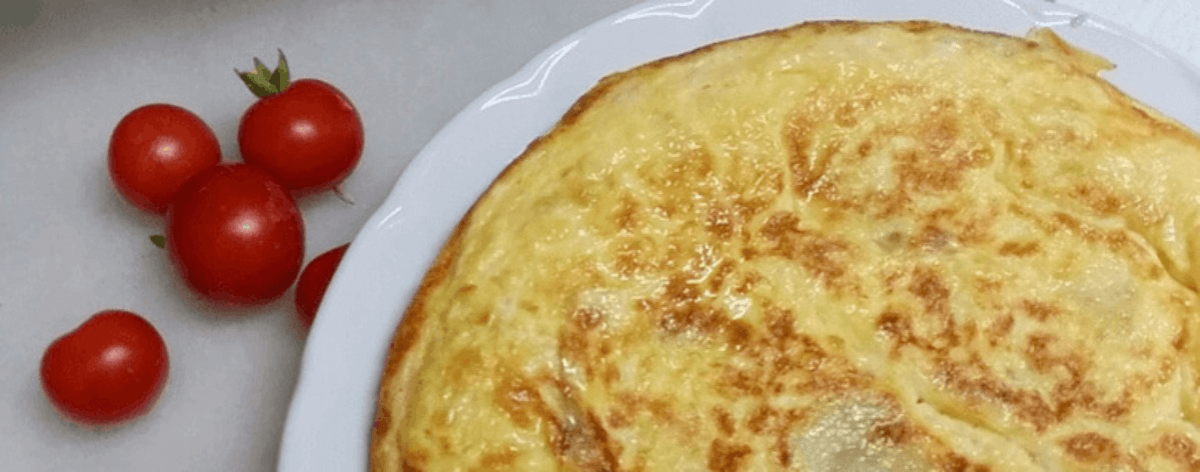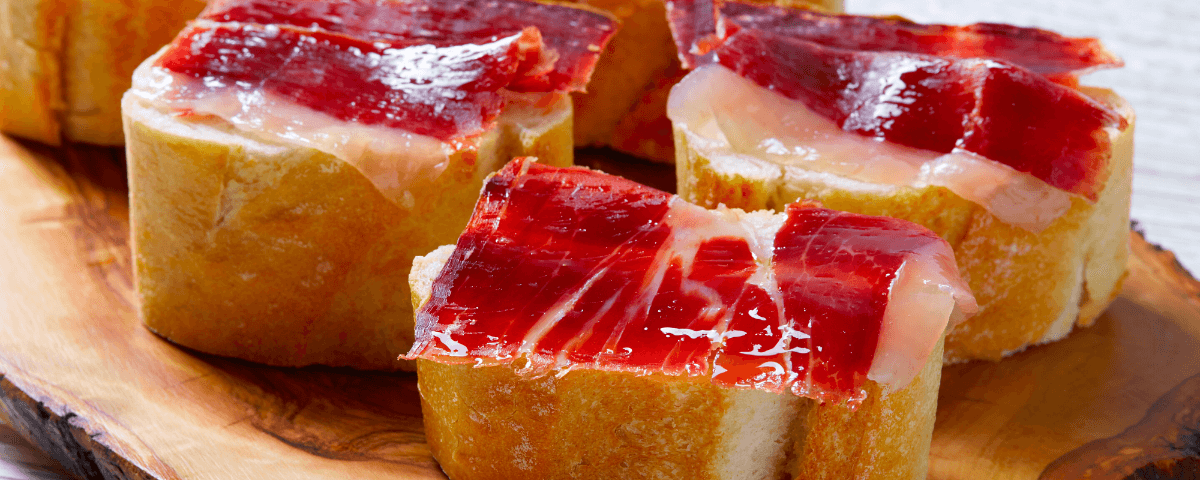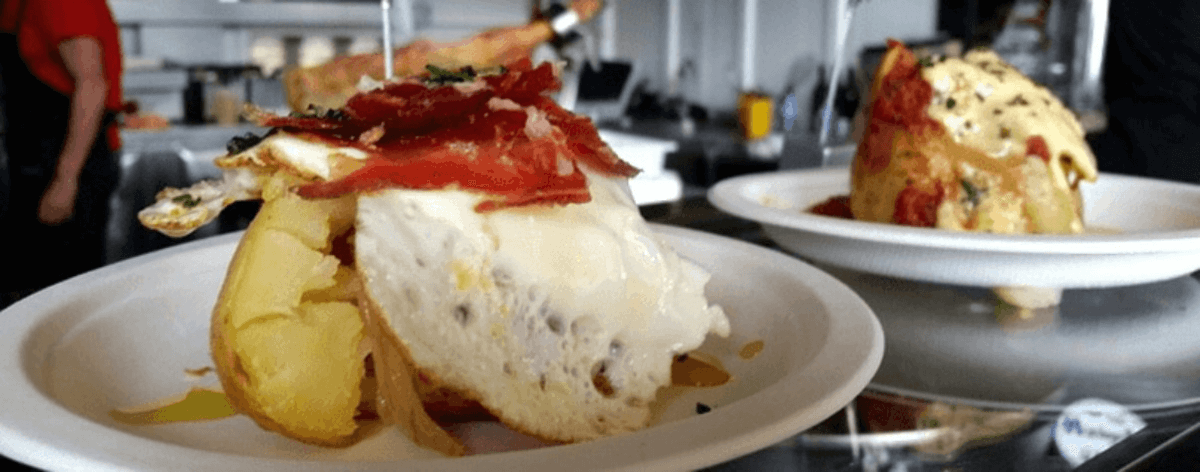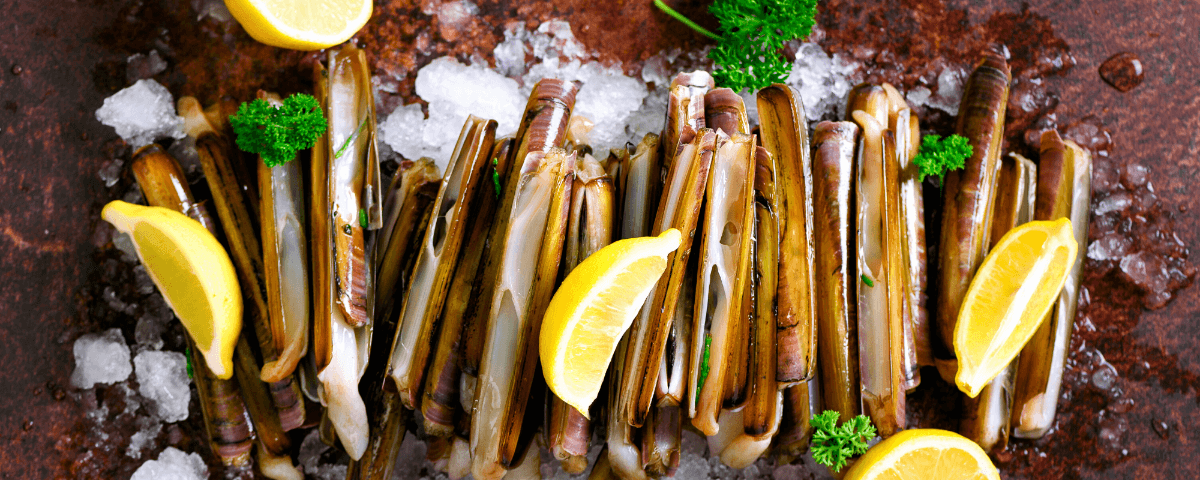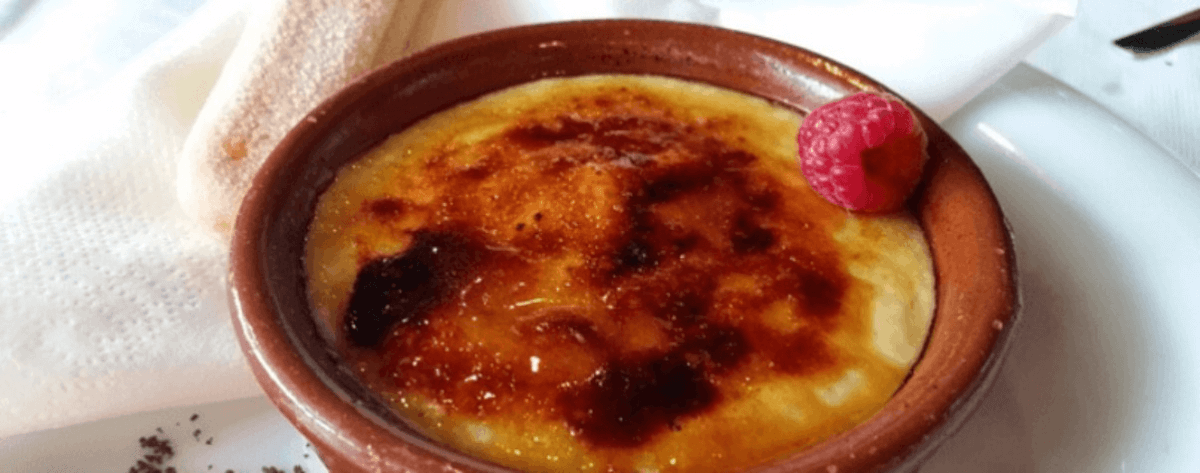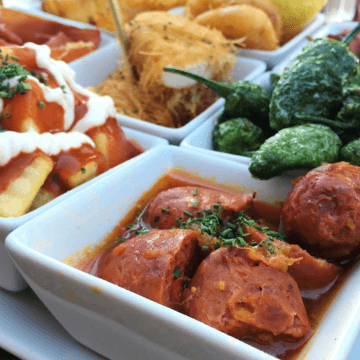
What is the best food in Spain I should try?
WHAT TO EAT IN SPAIN AND WHERE TO BUY SPANISH FOOD
Explore the savory delights of Spanish cuisine with us, from its most famous tapas to delectable desserts and of course the iconic Jamón Ibérico. A journey through all the dishes you must try during your next trip to Spain, with tips about when to order it, where to find it and even equally satisfying alternatives. You won’t find a guide to the food in Spain more useful than this one: it’s designed to help you planning your trip so you can try as many traditional Spanish specialties as possible as you go!
You’ll find here options for meat eaters, fish lovers and vegetarians, and you’ll be happy to know that many of them are also kid-friendly! Plus stick around till the end for a special bonus: a dish from each of Spain’s Autonomous Communities. Don’t limit your choices to just the classics: eat like a real local and try things probably your friends and family have never heard about before!
Put this Spanish food in your must-try list:
1
Jamon Iberico
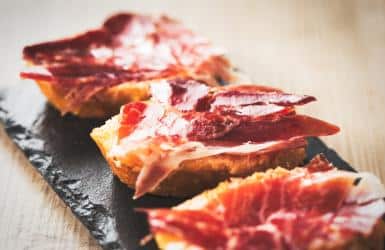
Maybe the most famous food from Spain, but one that is hard to find outside of this country, because what's exported the most is the cheaper "Serrano ham" variety (that locals use for their kids sandwiches, but not as an adult treat). The main difference is the bread of the pigs that is used to make one or the other. Iberico pigs give the best quality meat. A meant that melts in your mouth rather than getting chewy. A meat of a gorgeous intense dark red color, rather than the sketchy color of serrano with tints of orange.
And here goes my first important tip: when you buy Spanish food, educate yourself on the quality labels for each product so you aren’t for a ride. In the case of jamon, don’t just look out for the pig breed, but also what it’s eaten (“Bellota” means it’s been free-ranged eating wild eggcorns from the forest, whether “Cebo” or “Recebo” pigs ate cereals at the farm), its area of production (Jabugo being the most famous village for it), and even the number of years of aging (the difference between 3 and 5 years can easily be 100€/kilo).
WHEN TO EAT IT: Anytime.
WHERE TO TRY IT: Buy it at Charcuteria shops and supermarkets (sliced at the moment, or vacuum packed). Order it in tapas bars and restaurants.
HOW TO EAT IT: As a tapa (with toast or tomato bread, or as a platter), or as a starter to share. Sometimes it’s used in flakes or cubes to round up a dish.
ALTERNATIVES: If you don’t eat pork, try “cecina”, similar to ham but made with veal, or “mojama”, made with tuna fish.
2
Tortilla de Patatas (Spanish omelette)
When home-made, some people prefer to add caramelized onion to the mix, whereas other hate it. But when ordered at a restaurant the menus rarely mention if it’s got onion on it or not. Occasionally you’ll see it with added green peppers or chorizo bits.
WHEN TO EAT IT: Anytime, except maybe breakfast because eggs aren’t usually a breakfast food in Spain (unless the goal is to make it a decadent breakfast).
WHERE TO TRY IT: Buy it vacuum packed at supermarkets (not always great). Order it in tapas bars.
HOW TO EAT IT: As a tapa (with toast or tomato bread or by itself). At home, as a main course or a starter, sometimes with a salad or other light side dish.
ALTERNATIVES: Omelets galore! If you see them, don’t miss them: garlic & parsley omelet, “paisana” omelet with potatoes, peas and carrot, green onion omelet, eggplant omelet, zucchini omelet…
3
Paella
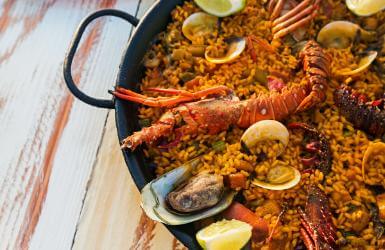
Need one more iconic dish from Spain? Of course Paella is the thing! HOWEVER, it's not a specialty that you find all over the country (at least not the best ones!), but mostly a thing from the Mediterranean Coast. The reason is that it's original from the region of Valencia, and that the water used to cook in other areas of Spain doesn't have the same degree of lime that allows for the rice to be cooked the same way. Paella takes hours to cook from scratch (family gatherings around a paella pan last until really late afternoon), and even at a restaurant it'll take at least 20 minutes to be served because that's how long the grain needs to be cooked. If it takes less than that, red flag! It's likely frozen stuff.
WHEN TO EAT IT: Lunch, please. It’s too heavy to have for dinner…
WHERE TO TRY IT: Ideally the region of Valencia in most restaurants. Otherwise restaurants along the Mediterranean coast usually do a good job (just not the ones with pictures of it by the door). If not visiting the coast, ask your hotel concierge if there’s any place at your destination that makes a decent one… or just skip it.
HOW TO EAT IT: As a main course, after a salad or a few light tapas shared with your table mates.
ALTERNATIVES: Fideua is sort of similar to paella but made with noodles instead, and it’s easily found along the Valencia and Catalunya coast. Or find out what other rice dishes are typical in the region you are visiting! You’ll be surprised to see that there’s more than paella to Spain!
4
Patatas Bravas
WHEN TO EAT IT: Anytime between noon and dinner.
WHERE TO TRY IT: Tapas bars, sometimes restaurants serve it as a starter.
HOW TO EAT IT: Share a platter with your travel mates.
ALTERNATIVES: Bravas with eggs? yes, please! That’s called huevos cabreados. Sometimes “huevos rotos” or “huevos estrellados”, but they don’t always come with the spicy sauce on top.
5
Olives
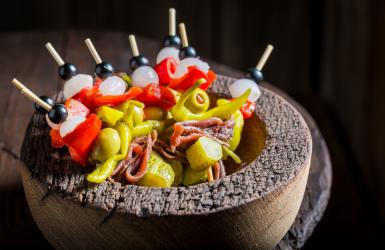
Did you know that Spain is the largest producer of olives in the entire world? And the largest producer of olive oil, as well? (hear that, Italy!). So don't come with the excuse that you don't like olives: there's not just one olive flavor! It entirely depends on the way it's been marinated! Maybe you hate black olives, but you'll love the redish "gazpachas" marinated with paprika. Or you hate green olives, but you'll love the bitter tiny "arbequinas" that you'll eat non-stop like sunflower seeds. And since we are talking about olives... Do yourself another favor and forget about bread and butter for just this trip. Bread and olive oil all the way!
WHEN TO EAT IT: On salads, or as a tapa or appetizer before lunch or dinner.
WHERE TO TRY IT: Buy them canned in supermarkets (acceptable taste and variety) or loose at farmers markets. Order it at most restaurants, bars and cafes.
HOW TO EAT IT: Share a platter with your travel mates.
ALTERNATIVES: That’s a tricky one… what about pickles and pickled baby onions and capers?
6
Gazpacho
WHEN TO EAT IT: In the Summer, anytime between noon and dinner.
WHERE TO TRY IT: Buy it refrigerated in supermarkets, or order it in most restaurants during the Summer months.
HOW TO EAT IT: Drunk if you are having it as a snack, with a spoon as a starter (soup) if you order it at a restaurant.
ALTERNATIVES: Salmorejo is a spread served as a tapa in Andalusia that uses similar ingredients.
7
Manchego cheese

Manchego cheese is the most famous cheese from Spain. It's a pressed sheep cheese made with milk from "manchega" sheep, in the region of La Mancha, and it's protected by a DOP label (Protected Denomination of Origin) since 1996. The outside rind is stamped with particular patterns that help releasing the whey during the curing process, which lasts 30 to 60 days. Even the Spanish writer Cervantes mentions it in his famous Quijote book.
WHEN TO EAT IT: Anytime.
WHERE TO TRY IT: Buy it in farmer markets, supermarkets, and delis. Order it in tapas bars and some restaurants.
HOW TO EAT IT: But itself as a snack or from a platter to share. On top of tomato bread or toast. Even as filling in sandwich!
ALTERNATIVES: Spain is a land of cheeses! In Galicia try Tetilla Gallega, in the Balearic Islands try Mahon, in Asturias try Cabrales, in Extremadura try Torta del Casar, in the Basque Country and Navarra order Idiazabal, in Catalonia don’t miss Mató served with honey for dessert.
8
Chorizo
WHEN TO EAT IT: Anytime.
WHERE TO TRY IT: Buy it in farmer markets, supermarkets, and delis. Order it in tapas bars and meat restaurants.
HOW TO EAT IT: Cured is eaten by itself, on toast (tomato bread doesn’t go too well with it) or as a sandwich. Cooked it’s often fried or cooked in wine, added as slices to stews or diced or grinded over migas (a breakfast dish based in bread crumbles), fries or eggs.
ALTERNATIVES: There’s so many other cold cuts worth trying! Look for salsichon, fuet, morcilla, lomo, sobrasada, longaniza…
9
Anchovies
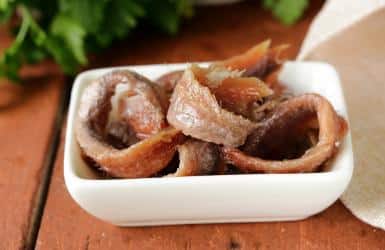
Anchovies are a fish from the same family of herring, that are cured in salt until its meat turns from white to brown. And I know, just like with olives, this is a Spanish food that has a lot of haters. But... that's maybe because you've only tried the super salty canned ones? And that's not the best version of anchovies! If you are willing to give them another try, then find anchovies from L'Escala (Catalonia) or Santoña (Cantabria). They are the very best.
WHEN TO EAT IT: Anytime.
WHERE TO TRY IT: Buy it in farmer markets, supermarkets, and delis. Order it in tapas bars.
HOW TO EAT IT: By themselves, as a topping on salad or escalivada (roasted red pepper, eggplant and onion) or on bread (toast, bread with olive oil or tomato bread).
ALTERNATIVES: Boquerones, the same fish but marinated in vinegar.
10
Calamares a la romana
WHEN TO EAT IT: Lunch or dinner.
WHERE TO TRY IT: Buy it frozen from supermarkets, then deep fry them at home and eat is a starter or main course. Order it as a tapa, starter or main in restaurants and tapas bars.
HOW TO EAT IT: Warm, and optionally sprinkle some lemon juice on top. In Madrid, try it on sandwich (“bocata de calamares”). Sounds weird? Spanish people thing meatball sandwiches are weird, too, LOL.
ALTERNATIVES: Rabas (deep fried calamari stripes), chipirones (fried battered baby squid).
11
Croquettes
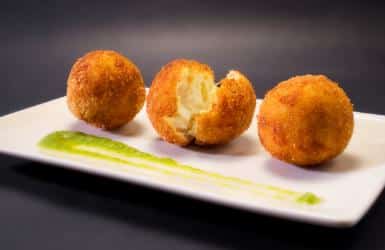
Another staple in the house, grandmas used to spend hours making a dense white sauce where they'd incorporate a variety of ingredients for flavor (often, just stew leftovers), before leaving it overnight to thicken, and then coating spoonfuls of that in bread crumbles and deep-frying them. I must confess that every time I've tried to make them from scratch they've melted as soon as I've put them on the pan... So thanks God for frozen ones!
The most common flavors are cocido (stew meat), chicken, ham, codfish, spinach and mushrooms. But you can also find them with shrimp, sobrasada, brie or blue cheese, eggplant, leek, gorgonzola, calamari ink… and in specialty bars you may even find sweet ones for dessert!
WHEN TO EAT IT: Lunch or dinner.
WHERE TO TRY IT: Buy it frozen from supermarkets, then deep fry them at home and eat is a starter or main course. Order it as a tapa or starter in tapas bars. Ask your concierge to find out if there’s any bar specializing in them if you want to try as many varieties as possible!
HOW TO EAT IT: Warm or room temperature.
ALTERNATIVES: Bomba, a Barcelona tapa similar to croquettes but made with mashed potatoes and spicy grinded meat.
12
Pulpo a la gallega
WHEN TO EAT IT: Lunch or dinner.
WHERE TO TRY IT: In tapas bars and fish restaurants.
HOW TO EAT IT: From a platter to share.
ALTERNATIVES: “pulpitos” (deep-fried baby octopusses), calamar en su tinta (canned calamari with ink), grilled squid (sepia).
13
Callos
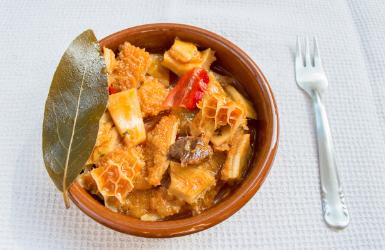
Where you looking for something more "exotic" and adventurous? No worries, we get you covered! In Spain offal food is quite common (although it takes too long to cook at home and now it's mostly grandmas and restaurants cooking them). And the most famous offal food in Spain is callos, cow tripe. They are served as a stew with other veal parts and pork meats such as chorizo and morcilla (blood sausage) slices and ham dices, Paprika gives it its characteristic reddish color.
WHEN TO EAT IT: They make a hearty breakfast ordered in bars, or a filling main for lunch. It’s usually considered too heavy for dinner.
WHERE TO TRY IT: In tapas bars and Madrid restaurants.
HOW TO EAT IT: As a tapa (but not really to share) or main.
ALTERNATIVES: In Catalonia order “Cap i Pota” (veal head and trotters stew). Otherwise “rabo de toro” (oxtail) and “manitas de cerdo” (pig trotters) are also a nice alternatives easy enough to find.
14
Pimientos del Padrón
WHEN TO EAT IT: Lunch or dinner.
WHERE TO TRY IT: Buy them fresh to cook at home in grocery shops, markets and supermarkets. Order it at tapas bars and restaurants.
HOW TO EAT IT: As a tapa to share or as a side dish.
ALTERNATIVES: Escalivada, a Catalan specialty that is basically slices of roasted eggplant, red pepper and onion. Pimientos del Piquillo, roasted small red peppers served either stuffed or cut in slices over bread or salad, or entire as a side dish or tapa.
15
Gambas al ajillo
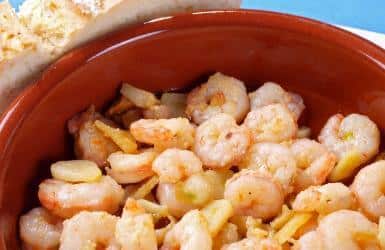
Shrimp is a delicacy that is easily found along all the Spanish coast. And while it can be served grilled or as an ingredient of paella and other dishes, one of our favorite ways to make them is cooked in olive oil and garlic, and often also a couple of chilies. It's usually served either on a small pan or a small clay pot. Don't forget to order some bread to soak in the oil and clean the plate! Yum! Oh, and don't worry, in this dish shrimp comes already shelled!
WHEN TO EAT IT: Lunch or dinner.
WHERE TO TRY IT: Buy them fresh to cook at home in fishmongers and markets. Order it at tapas bars and fish restaurants.
HOW TO EAT IT: As a tapa to share, or as a starter.
ALTERNATIVES: If you are not a shrimp person, but you do love garlic, try “pollo al ajillo” instead (chicken fried with garlic and parsley).
16
Bacalao al pil pil
WHEN TO EAT IT: Lunch or dinner.
WHERE TO TRY IT: Buy them fresh to cook at home in fishmongers and markets. Order it at tapas bars and fish restaurants.
HOW TO EAT IT: As a tapa, starter or main course.
ALTERNATIVES: In Catalonia cod is made “a la llauna” (cooked on a tin with oil and paprika). You’ll often find also cod turned into fritters or croquettes, or added to rice dishes. Not a fan of cod? Try monkfish instead!
17
Cochinillo (Lechón)
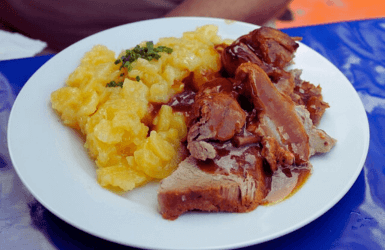
Roasted suckling pigs are very traditional in the areas of Castilla and Madrid (center of Spain), and the specialty of one of the oldest restaurants in Spain: Restaurante Botin in Madrid. Another very famous restaurant for them is Meson de Candido in Segovia. The baby pig is cleaned from all the organs but the kidneys, which add flavor to it, then baked in the oven whole on a clay pot with herbs and its own grease.
WHEN TO EAT IT: Lunch or dinner.
WHERE TO TRY IT: Meat restaurants.
HOW TO EAT IT: As a main course.
ALTERNATIVES: Lechazo or cordero asado (sukling lamb).
18
Hot chocolate with churros
WHEN TO EAT IT: Breakfast or late afternoon snack (merienda). Sure, in Barcelona I’ve seen some tapas bars starting to serve them as dessert, too, but Spanish people roll their eyes at that. As a pick-me up bought from a churreria truck after partying the whole night long.
WHERE TO TRY IT: Buy chocolate powder to make at home in supermarkets (or ready made chocolate in tetrapack, that you only have to warm on the microwave!). Order it in cafes and “granjas” (in Catalonia, cafes specializing in dairy products). You’ll also find it in “churrerias”, shops and food trucks specializing in churros (usually there the churros are delish but the chocolate is just OK).
HOW TO EAT IT: Order a “suizo” to get it topped with whipped cream (only in granjas and cafes).
ALTERNATIVES: For a more liquid chocolate, Cacaolat is the most famous brand of chocolate shake. In Catalonia, melindros (lady fingers) are also commonly dipped in hot chocolate. And at home strips of toast do the trick, too. Or really, any kind of pastry works. Porras are a thicker type of chocolate, that sometimes comes stuffed with chocolate or cream.
19
Crema Catalana
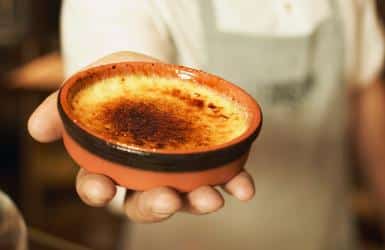
And let's start now with sweet specialties! In reality, in Spain you'll often find a typical dessert or pastry for each celebration along the year. But there's things that are there all year around! And Crema Catalana, the Catalan creme brulee, is one of them. But creme brulee is richer and has a vanilla flavor, whereas Crema Catalana is thicker and has a cinnamon and lemony aftertaste.
WHEN TO EAT IT: Lunch or dinner, or as a rich breakfast or late afternoon snack (merienda)
WHERE TO TRY IT: Most restaurants, tapas bars and “granjas” (in Catalonia, cafes specializing in dairy products).
HOW TO EAT IT: As dessert or sweet treat.
ALTERNATIVES: Arroz con leche (rice pudding), flan (creme caramel), natillas (custard), torrijas (French toast).
20
Ensaimada
WHEN TO EAT IT: Breakfast or late afternoon snack (merienda).
WHERE TO TRY IT: Buy then in bakeries and cake shops, or find industrial ones in supermarkets. Order it in cafes and bars.
HOW TO EAT IT: By itself, or dipped in coffee, milk or hot chocolate.
ALTERNATIVES: Xuixos (Catalan deep fried roll stuffed with custard), palmera (puff pastry), tortas de aceite.
21
BONUS! Best regional food in Spain, by Autonomous Community
- ANDALUSIA: Pescaito frito (baby fried fish).
- ARAGON: Frutas de Aragon (candy fruit coated in chocolate).
- ASTURIAS: Cachopo (giant schnitzel made with two steaks, ham and cheese).
- BALEARIC ISLANDS: Sobrassada (paprika pork sausage spread)
- BASQUE COUNTRY: Pintxos (tapa consisting on a slice of bread with a variety of toppings)
- CANARY ISLANDS: Papas arrugás con mojo picón (boiled potatoes with their skin, with a spicy sauce)
- CANTABRIA: Sobaos passiegos (breakfast bakery)
- CASTILLA Y LEON: Garlic soup
- CASTILLA LA MANCHA: Marzipan from Toledo
- CATALONIA: Butifarra amb seques (pork sausage with white beans). And of course, “pa amb tomàquet”, bread with tomato rubbed on top.
- VALENCIA REGION: Horchata with fartons (vegetal milk with lady fingers to dip in)
- EXTREMADURA: Ajoblanco (almond gazpacho)
- GALICIA: Empanada gallega (tuna pasty)
- LA RIOJA: Rioja-style cod (stewed with tomato and red peppers)
- MADRID: Cocido Madrileño (traditional meat stew)
- MURCIA: Paparajotes (sweet battered lemon tree leaves – you really only slurp out the batter, you don’t eat the actual leave)
- NAVARRA: White asparagus
Now it's your turn, what do you think is the best food in Spain?
Marta
RESEARCHING FOR A TRIP IS TIME-CONSUMING…
Need more inspiration?
Our 100% FREE Barcelona Collection will give you everything you need to organize the trip of your lifetime to Barcelona.
BEST INSIDER TIPS FROM THE PROS!


